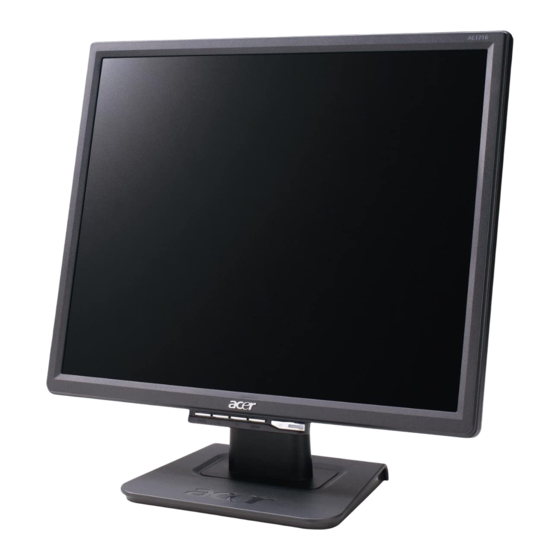Acer AL1716W Service Manual - Page 7
Browse online or download pdf Service Manual for Monitor Acer AL1716W. Acer AL1716W 50 pages. Acer computer monitor user guide
Also for Acer AL1716W: User Manual (17 pages)

ACER AL1716W
6
Go to cover page
1.7 Controller Requirements:
1.7.1 General Requirements: The monitor shall
include a controller capable of converting the
analog RGB signal from a standard WXGA
resolution video controller in the CPU to a signal
which can be displayed on the panel. The
controller will include a PLL, A/D converters,
and other circuitry necessary to perform its
function. The PLL shall be stable enough to
ensure that a static image from the CPU is
placed in the same physical location on the flat
panel in each frame.
1.7.2 Video Stretching: The monitor shall contain
provisions to "stretch" the video signal, so that
an input signal from the computer in any
resolution smaller than 1440 x 900 is
automatically expanded to fill the entire screen.
1.7.3 Panel Timing and Interface: The controller
supplied with the monitor shall control all
panel timing. This controller shall adequately
insulate the monitor from the computer, so that
no possible combination of input signals from the
computer shall cause damage to the flat panel or
any other component of the monitor. The LCD
panel interface shall support the TFT standard.
1.8 DC - AC Inverter Requirements:
The frequencies used by the DC-AC inverter used to
power the backlight shall be chosen so as to prevent
any noticeable effects on the flat panel (such as a
rolling effect).
1.9 Power Supply Requirements:
The AC to DC converter power supply for the monitor
shall be an integrated power supply. This power supply
shall have an IEC receptacle for mains power input and
provide sufficient power for the monitor, the backlight
assembly and the "Dell Sound bar", and shall meet all
requirements specified in Table 2.
1. Product Specification (continued)
Table 2. AC TO DC Converter Requirements
Input Voltage Range
Input Frequency Range
Power Consumption
Line Fuse
Initial Cold Start
Inrush Current
Hot Start Cycle
Under Voltage
Line Transient
1.10 Display Communications Channel:
The monitor assembly shall provide a display
communications channel that conforms to VESA
DDC2B hardware requirements. This configuration
shall contain the 256-byte EDID file as specified by
VESA E-EDID Standard. The monitor contains a
separate EEProm for each video input to store EDID
information. Once the EDID is programmed there is a
write protection that is enabled so that the EEPROM
cannot be overwritten.
The operating range shall be from 90 to 240 VAC
sinusoidal for all models specified.
Input power frequency range shall be from 47.5 to 63Hz
over the specified input voltage range.
Power consumption for the monitor shall be less than
75W over the specified voltage and frequency ranges. In
power off mode the power consumption will be less than
1W (at 90VAC~240VAC).
The AC input shall be fused and become electrically open
as a result on an unsafe current level. The fuse may not
be user replaceable.
The power supply shall start and function properly when
under full load, with worst case conditions of input
voltage, input frequency, operating temperature, and cold
backlight lamps.
The inrush current must be limited to 42A when operated
at 120VAC, and 80A when operated at 220VAC. In - rush
current is measured at an ambient temperature of 25° C,
with the unit temperature stabilized in the power - off
The power supply shall not be damaged when switched
ON for one second and OFF for one second for seven
consecutive times after operating for one hour at full load,
25°C, and nominal input line voltage.
The power supply shall contain protection circuitry such
that the application of an input voltage below the
minimum specified in this table shall not cause damage
to the power supply unit nor cause failure of the input
The power supply shall operate within IEC 801-4 (±1KV)
and IEC 801 -5 (±2KV) for the domestic U.S. Version.
The UPS power supply shall operate and comply with CE
mark.
